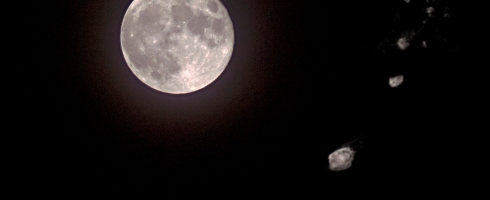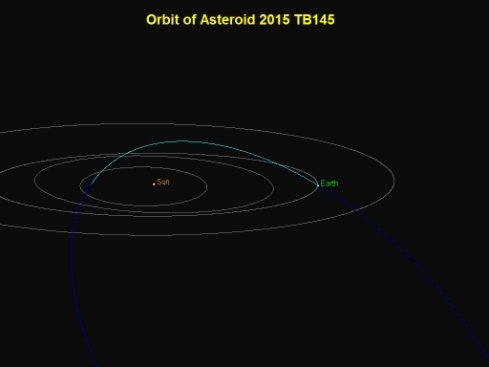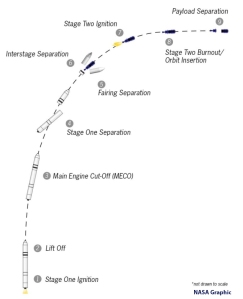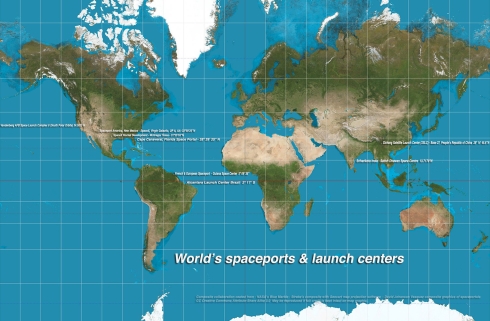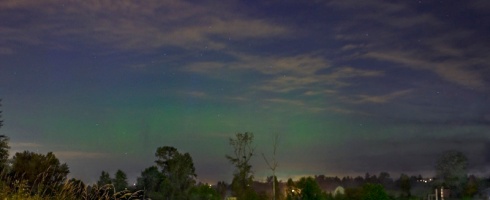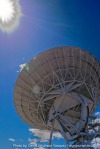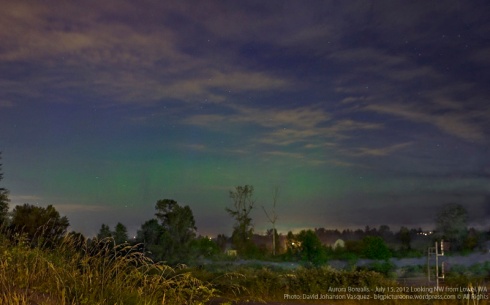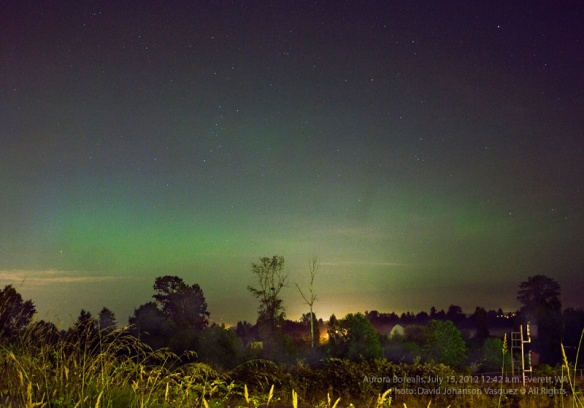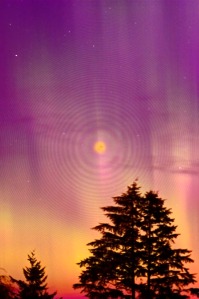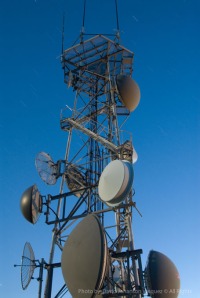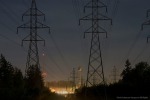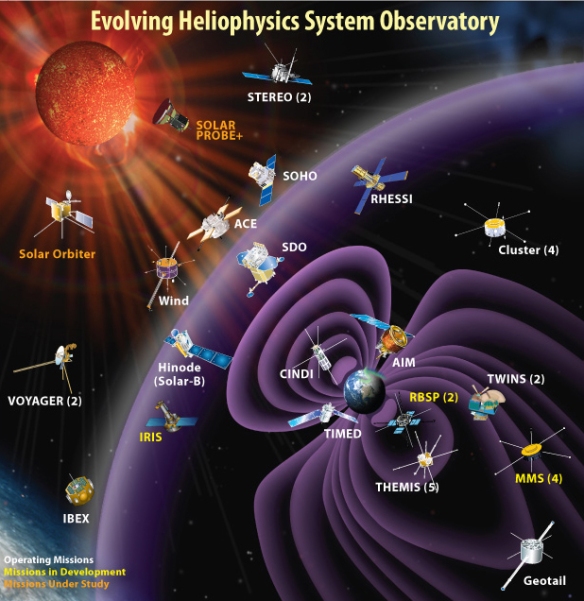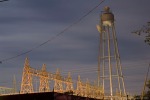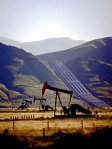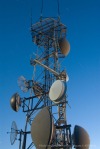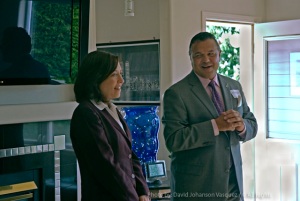Essay and photos by: David Johanson Vasquez © All Rights
This essay will have Solar Storm forecast and updates located above the story’s first photograph . These updates will be posted anytime a major solar disturbance is cited. Please read the essay first and return at anytime to view posted updates.
Prepared jointly by the U.S. Dept. of Commerce, NOAA,
Space Weather Prediction Center and the U.S. Air Force.
Updated 2013 Jul 19 2200 UTC
Joint USAF/NOAA Solar Geophysical Activity Report and Forecast
SDF Number 200 Issued at 2200Z on 19 Jul 2013
IA. Analysis of Solar Active Regions and Activity from 18/2100Z to
19/2100Z: Solar activity has been at very low levels for the past 24
hours. There are currently 7 numbered sunspot regions on the disk.
IB. Solar Activity Forecast: Solar activity is likely to be low with a
slight chance for an M-class flare on days one, two, and three (20 Jul,
21 Jul, 22 Jul).
IIA. Geophysical Activity Summary 18/2100Z to 19/2100Z: The geomagnetic
field has been at quiet to unsettled levels for the past 24 hours. Solar
wind speed, as measured by the ACE spacecraft, reached a peak speed of
674 km/s at 19/1650Z. Total IMF reached 12 nT at 18/2100Z. The maximum
southward component of Bz reached -9 nT at 19/0122Z. Electrons greater
than 2 MeV at geosynchronous orbit reached a peak level of 2710 pfu.
IIB. Geophysical Activity Forecast: The geomagnetic field is expected
to be at unsettled to minor storm levels on day one (20 Jul), unsettled
to active levels on day two (21 Jul) and quiet to unsettled levels on
day three (22 Jul).
III. Event probabilities 20 Jul-22 Jul
Class M 15/15/15
Class X 01/01/01
Proton 01/01/01
PCAF green
IV. Penticton 10.7 cm Flux
Observed 19 Jul 114
Predicted 20 Jul-22 Jul 115/115/115
90 Day Mean 19 Jul 121
V. Geomagnetic A Indices
Observed Afr/Ap 18 Jul 016/015
Estimated Afr/Ap 19 Jul 011/014
Predicted Afr/Ap 20 Jul-22 Jul 014/020-011/015-008/010
VI. Geomagnetic Activity Probabilities 20 Jul-22 Jul
A. Middle Latitudes
Active 35/30/25
Minor Storm 20/10/05
Major-severe storm 05/01/01
B. High Latitudes
Active 10/15/15
Minor Storm 25/30/30
Major-severe storm 50/40/30

Sunday morning, July 15. 2012 – Aurora Borealis NW view from Lowel Snohomish Riverfront Park. David Johanson Vasquez ©

- A powerful solar storm’s charge particles interact with Earth’s atmosphere; creating translucent shimmering curtains of light known as the Aurora Borealis. Photograph taken in 2003, near Seattle, looking North. Camera: Nikon D200
-
This year has seen a steady influx of news reports on increased solar storm activity hitting the Earth. Most broadcasts concerning this development are of a less serious kind, featuring its spectacular visual effects, which creates the unworldly, “Northern Lights” or “Aurora Borealis.” However, a few reports have mentioned necessary cancellations of airline flights using trans-polar flight routes‑‑‑due to the sun’s disruptive solar flares. This particular solar activity is nothing new, but a recurring event; which has taken place countless times before civilization ever existed on Earth.
What’s of concern to us today is the 11-year peak cycle, of which the sun now is entering, resulting in extreme solar storm activity. Some solar physicists predict the current cycle of storms may have greater magnitude than any before, including the record solar maximum, chronicled over 150 years ago, in the year of 1859.



Why should anyone care if the solar storm activity becomes more intense than any other time in recorded history? Simply stated‑‑‑civilization as we know it, could be stopped in its tracks or altered to resemble something not recognizable. Imagine not being able to turn on lights for illuminating your home or office: communication by phone, email and social media all gone, with no guarantees as to when it could or would be back online. There’s other challenging issues regarding basic, food production and distribution. These are potentially extreme, but possible scenarios from a major solar storm known as a “coronal mass ejection” (CME), which could knock out virtually any technology, requiring electricity. This event could take away most of the technology we depend on and ironically transports our way of life back to the time when the last great CME hit.

If you had a window, which peered back-in-time to the end of August, 1859; you’d see a developing western society on track with an industrial revolution in full-motion. Harnessing the new wonders of steam energy was nearly complete, however, electrical energy barely had reached its first phase of infancy. Few applications for electricity existed, except for a remarkable one in the form of instant communication. By sending electrical pulses through copper wires to a remote electromagnetic receiver, messages were transmitted instantly over great distances. The telegraph could be considered a 19th Century equivalent of today’s Internet. This system used a basic, universal binary code developed primarily by the American artist, Samuel F.B. Mores. By the mid 19th Century, scientist demystified electricity’s secrets, and inventors found ways to harness it for communication using “direct current.

As the summer heat of September approached the northern hemisphere: a series of solar storms increased with startling intensity; producing extreme Northern Lights, which appeared in unlikely places, such as the Caribbean near the equator. Inhabitants reported in Northeastern America by using the intense Northern Lights to read newspapers with, during the dark hours of the night. Other stories mention groups of people being awakened by this strange, bright light and believing it was actually morning. All over the World, compasses used for navigation (the rough equivalent of today’s GPS) were no longer giving accurate readings as the Earth’s geomagnetic forces were being distorted by the solar storm’s energy.

- Sunspots were first documented by Galileo in the 17th century, these solar disturbances contribute to solar storms.
Sunspots on the Sun’s (technically, the Sun is a G-type main-sequence star) surface, contributes to forming solar storms, of which Galileo had first observed in the 17th Century and by 1745 solar flares were well documented. Up until 1859, the solar storm only known effects on humans were producing a dazzling display of cosmic fireworks, located far into the northern and southern hemispheres.

The uniformed industrial age public had no reason to be concerned as the peak of the solar storm began arriving on September 1st and 2nd. These extreme, violent sun flares, hurled enormous magnetic clouds of plasma into space, known as a coronal mass ejection (CME). This CME solar storm became known as the Carrington Event, named for a British astronomer who first recognized and identified its geomagnetic effects on Earth.
Solar ejections normally take three to four days before reaching Earth, but this extreme burst had a hyper-velocity, which took less than 18-hours for the shock waves to compress the Earth’s protective magnetic field. As the surge of solar electromagnetic energy overpowered and broke through part of the Earth’s own protective magnetic field, some alarming events began happening. First came a series of random, garbled telegraph signals being picked up, which mysteriously had not been sent by an operator; then reports of receivers beginning to violently catch fire and setting secondary fires to office papers along with telegraph lines. Jolts of electricity nearly electrocuted some operators while attempting to disconnect the system’s electrical batteries; even with their disconnection, frenetic signals continued out-of-control from massive energy overflows: the geomagnetic super-storm was sending dangerous charges of electricity through the lines. The event devastated an emerging communication infrastructure and severely set back its development. This record solar storm event appeared on the scene, well before societies and industries realized electricity’s great potential; much less its inclusive, necessary use in just about every part of the technology we use and take for granted today.

Until recently, I’ve always looked forward to the Northern Lights dazzling arrival. I recall my first Aurora Borealis encounter shortly after graduating from college, while on a road trip to the Olympic Rain Forest. Camping out in the Olympic Mountains, the northern sky began glowing at twilight with vivid illuminating curtains moving until they were flashing directly overhead. I kept watching the surreal specters until they exited out of view an hour later.
The next time I viewed these mysterious lights happened on a photography assignment to North Slope oil fields, located above Alaska’s arctic circle. The Earth’s natural magnetic field, which protects the planet from much of the sun’s solar radiation, is weakest near the Earth’s polar regions; allowing for solar winds to enter and interact with our atmosphere to create the Aurora. This is why the cosmic lights are viewed while looking north, in the northern hemisphere and the reverse for the southern hemisphere. Captivated by the up-close experience of the Aurora’s light; I endured the extreme outside temperature which was minus 40 degrees. Facing frigid arctic weather, I photographed the light show, until the springs controlling my camera’s shutter began to freeze up.
Actually today’s digital cameras make it easier to photograph the northern lights. Professional digital cameras are much more sensitive for capturing low light subject matter,than film was and it has a better tonal-dynamic-range.
My all time favorite Northern Lights experience was in Eastern Washington where I was on a ranch in the Okanogan region. This encounter was so full of bright light, it woke up birds from a night’s sleep and they began to take flight while making loud, chirping sounds as if dawn had arrived. In this environment, with no light-pollution from a city; while at a 5,000 foot elevation made for an ideal night-sky photography experience.
In 2003 was one of the greatest solar flare events in contemporary history; the Northern Lights were so intense, I easily photographed them from my home in Western Washington. Despite the bright lights coming from a nearby city they did not obscure the Aurora Borealis view. The photos of the Northern Lights used in this essay are ones taken from my home. In these images you can see the glowing translucent green, red and purple color produced, as the sun’s energy interacts with various gas elements which comprise the Earth’s atmosphere.

The reason for solar flares are to peak this year, or possibly in early 2013, is due to the sun’s magnetic field reversing polarity within an 11-year cycle. It takes a full 22-years in these magnetic fields to return to their original pole positions which then completes a full cycle. Apparently near the 11-year cycle, which our store now has entered, the solar flare activity becomes more intense.
The 1859 record solar maxim was on one of these 11-year cycles. Another theory connected with returning mammoth CMEs is the high quantity of sunspots recorded over the past couple of decades. Sunspots appear when portions of our star’s internal superheated matter, mixes with cooler regions above the surface; creating intense magnetic fields. These magnetic fields are swept up, and then forced below the surface, where they become recycled by the sun’s complex quantum mechanics. Energy from sunspots becomes amplified creating even more extreme magnetic fields as they resurface from a four or five-year subsurface journey. These magnetic disturbance interact to create concentrated arcs of solar energy, which are so powerful they become ejected outward in the form of solar flares.

The other methods scientist uses for estimating the potential scale of this year’s solar storms is to examine recent solar cycles; and look for progressive trends or patterns for their projections.
In 1989 a CME hit the Earth with intense energy particles, causing the electrical grid in Quebec, Canada, to crash, which plunged millions of people into darkness. This event took place during the “cold war” and it caused severe shortwave radio disruptions with Aurora Borealis sightings in south Texas. Some believed it was the beginning of a Soviet nuclear first strike, using intense electromagnetic energy to disrupt communications and electric grid infrastructure. In reality, it was caused by a CME, created from the sun’s own nuclear energy. Acting like a giant teetering domino, the event triggered a chain reaction, taking down interconnecting electric networks within a large region of North America‑‑‑but even this event was not on a scale with the mega storm of 1859. That’s why some scientist view the 30-year old, Hydro-Quebec solar storm as a telegraphed alarm warning.

With demand for power growing even faster than the grids themselves, modern networks are sprawling, interconnected, and stressed to the limit—a recipe for trouble, according to the National Academy of Sciences: “The scale and speed of problems that could occur on [these modern grids] have the potential to impact the power system in ways not previously experienced.” There’s fear the expanded network of lines creates a bigger antenna enabling it channel a geomagnetic induced current (GIC.) NASA has become alarmed with how much more vulnerable the North American power grid has become, it co-developed an experimental program called “Solar Shield” to help warn utilities of impending geomagnetic storms.
Since 1989 we have become much more dependent on microelectronics, with their intricate architecture of high density, compressed components. Having unshielded microcircuits squeezed tightly together increases the odds of severe damaged caused from geomagnetically induced currents (GICs). The 1989 solar storm event damage at least 30 satellites, some of which were beyond repair. Solar storms can easily scramble the intricate digital components of low-orbit satellites and disorient them from knowing which way is up or down. In theory, with enough warning, orbiting satellites are safely switched off or pointed away from the sun’s destructive radiation.
Early warning satellites are now positioned at a L1 point, geostationary orbit to monitor solar storms and announce threatening CME activity. The Solar Shield Project is a collaboration between NASA Goddard Space Flight Center and Electric Power Research Institute (EPRI). The purpose of this project is for establishing a forecasting system, which can be used to lessen the impact of geomagnetically induced current (GIC) on high-voltage power transmission systems. (Please see associated link bellow for more information.)

The Earth’s atmosphere and magnetic fields normally protect us from the harmful solar storm’s radiation. Higher exposure to the sun’s powerful energy becomes a factor once you start climbing in elevation. Radiation exposure is a secondary reason why airlines must divert from their trans-polar routes, to avoid excessive exposure. Disruption of GPS and radio communication from the solar storms is the primary reason for flight diversions.
Astronauts working above Earth’s protective atmosphere face the greatest risk from such effects caused from solar flares. These stellar storms have shortened or alter a number of space missions in the past. The Russian’s space station MIR in 1993 had an unfortunate encounter with a solar storm, exposing the cosmonauts to dangerous levels of over 10 times the normal allowable radiation limits.

What could be the most likely indicators of an impending maxim solar disturbance? So far, NASA and NOAA are the only government agencies I’m aware of who’s keeping the public informed with the most current status of solar flares. At the end of this essay are links, which give important information on this year’s solar storms including: NASA and NOAA sites, which are monitored hourly conditions. If solar storm activity becomes alarming, NASA will most likely be out front with the reports and major news networks will probably soon follow. If a certain threshold of (x-rays) is reached within the first phase of a major solar storm, the FAA will order cancellations of airlines with trans-polar flights. Disruption of shortwave radio communication is the earliest indicator of a severe storm. If conditions become dire, all but emergency flights would be grounded indefinitely.
 NASA would issue orders to evacuate astronauts from the International Space Station, this would probably be a strong indicator the radiation levels from the second phase of a storm are severe. Supposedly the center of the Space Station has enough mass to offer some protection from this type of event, but NASA would probably play it safe and order emergency return flights, that is, if there was enough time. Seeing the Northern Lights close to the equator would be a strong indicator the Earth’s geomagnetic fields were being overrun, meaning the big one might be arriving. If a major CME (the particle phase of a storm) comes our way, there may be 18 hours or less to prepare.
NASA would issue orders to evacuate astronauts from the International Space Station, this would probably be a strong indicator the radiation levels from the second phase of a storm are severe. Supposedly the center of the Space Station has enough mass to offer some protection from this type of event, but NASA would probably play it safe and order emergency return flights, that is, if there was enough time. Seeing the Northern Lights close to the equator would be a strong indicator the Earth’s geomagnetic fields were being overrun, meaning the big one might be arriving. If a major CME (the particle phase of a storm) comes our way, there may be 18 hours or less to prepare.
 On the positive side, unlike a major earthquake or other natural disasters we at least have some time to ready and brace for a worst case scenario.
On the positive side, unlike a major earthquake or other natural disasters we at least have some time to ready and brace for a worst case scenario.

It would be an unfortunate irony if the sun made our world go dark, but here’s how it could happen. The National Academy of Science produced a 2008 report warning, if we had another major solar storm like the 1859 Carrington event, we would have extensive blackouts with the loss of key transformers.
Our Nation’s electrical utilities have in all total, less than 400 major transformers supply all the power we use. There are no longer any companies within the US which make massive sized transformers. If an extreme solar maxim arrives, we’ll probably be on a long waiting list (along with the rest of the world) for key replacements. Given enough time, they can be built domestically, but it could take years and a major obstacle is transformers require a huge amounts of electricity for their construction. Even without a disaster happening, electric utilities face a minimum of two-years from when a major transformer (average cost 4 million dollars) is ordered and finally installed (according to a global, equipment insurance company.) Critical shortages of raw materials and trained workforce for installation contribute to this problem. Hopefully the utility company supplying your community power; learned a lesson from the 1989 Hydro-Quebec blackout.
There are preventive strategies to guard against geomagnetic induced current (GIC)— such as “solid ground system;” which is an industry design to help protect electrical infrastructure from a nuclear induced: electromagnetic pulse (EMP.) An EMP creates a tremendous amount of electromagnetic energy, similar in some ways to a naturally occurring solar storm CME. The next best plan for the electric utilities is to disconnect the power lines from any of its key equipment threaten by massive surges of electromagnetic energy. Just disconnecting lines could prove ineffective if a surge was big enough. The connecting leads to a transformer could possibly be used as an antenna for attracting the surge of electromagnetic energy.
There is something you can do to protect your own electrical devices from the devastating effects of either a solar CME or a nuclear EMP. You can easily, with very little cost, build what is known as a Faraday cage to protect your equipment. For instance for: a radio, cell phone or batteries (all of which are vulnerable to massive electrical surges;) you first wrap the devices in thick plastic like a freezer bag or bubble wrap, then use three layers of aluminum foil to completely wrap the devices so there are no gaps. The plastic acts as an insulator from the metal foil which intern deflects energy.
I’ve included a web link to an electrical engineer’s website who explains the procedures and others for protecting against Solar CMEs or EMPs. You can also do a google search for Faraday cage. Unplugging your electrical equipment from the outlets is a good safety precaution, which ordinarily could protect you against a lightning storm, but will probably not prevent your electronics from being fried from a major CME. If you remembered what happen to the telegraph system, which was hit by the largest CME in history in 1859, the electromagnetic energy used the unconnected wires from the telegraph as an antenna to channel its force through. Tesla, the great inventor who championed AC electrical power proved electrical transmission could efficiently be sent through the air without using power lines.
 One other critical infrastructure which could be devastating from a CME or EMP is major pipelines. The metal in power-lines a pipelines is a great conductor of geomagnetic energy. The test has shown electromagnetic surges can affect the controls for monitoring pressure and flow of buried high-pressure pipelines. In Russia it was found past solar storms had caused severe corrosion effects of some of its pipeline; apparently this is not as much of an issue in the North America because the pipe manufacturing process.
One other critical infrastructure which could be devastating from a CME or EMP is major pipelines. The metal in power-lines a pipelines is a great conductor of geomagnetic energy. The test has shown electromagnetic surges can affect the controls for monitoring pressure and flow of buried high-pressure pipelines. In Russia it was found past solar storms had caused severe corrosion effects of some of its pipeline; apparently this is not as much of an issue in the North America because the pipe manufacturing process.
For most civil preparedness involving impending emergencies, it’s best to listen to experts who advise: always have enough: food, water and flashlights on hand to survive what happens after a major natural disaster event occurs. A good plan for how to keep in contact with family members will be critical if a major solar storm event occurs; especially with an extreme maxim CME as communication equipment will be toasted unless it was properly shielded from the event. Self-reliance is a good policy to help weather any type of storm or catastrophe. Most of the commonsense preparations mentioned in this essay are basic ones every family should have in-place in case of an earthquake or any major disaster.
Will a decimating solar storm hit in 2012 or 2013? No one can forecast for certain how severe this solar maxim will or will not be; but if the there’s enough strength behind the solar storm and its path becomes directly aimed towards Earth, then it could be the greatest challenge civilization has ever faced. Learning from the lessons of history has been an essential part of the human experience; we successfully thrive in the moment by learning from histories past events. This seems so obvious, but it involves a fine-tuned balancing act between what we carefully choose to forget of painful tragedies and remember of inspirational triumphs. Ideally, the value of any-type of learning produces confidence and preparedness for future encounters, situations and events.
Given a solar CMEs disruptive potential, it’s in everyone’s self-interest to judge the potential risk; then have an action-plan to help lessen the life-altering impact of an extreme act of nature. Personally, I don’t sense any impending doom with this year’s solar maxim. By doing basic research to become educated on solar events, I gained knowledge of the potential for some disruption to our infrastructure; with this awareness I’m confident I’ve taken the necessary precautions for my family to best be ready for this and any future natural disasters, which may arrive from over the horizon. —

- The Aurora Borealis or Northern Lights have been revered and feared by ancient and prehistoric cultures. The phenomena are created from solar winds colliding and interacting with Earth’s atmosphere.
- .
- .
Fantastic time-lapse video of the Aurora Borealis, click on the link below.
↓
http://vimeo.com/11407018
Below are useful links related to the subject solar storms including official government agencies including: NASA and NOAA. Other sites and articles include those from: National Geographic, Washington Post and Christian Science Monitor.
To visit the following sites: copy and paste these links into your browser or highlight them and use a right mouse click.
http://www.swpc.noaa.gov/
http:science.nasa.gov/science-news/science-at-nasa/2003/23oct_superstorm/
Solar Shield Project is a collaborative project between NASA Goddard Space Flight Center and Electric Power Research Institute (EPRI). http://ccmc.gsfc.nasa.gov/Solar_Shield/Solar_Shield.htmlhttp://soho.nascom.nasa.gov/data/realtime-images.html
An electrical engineer, who gives great information on how to protect your electrical components from EMP blast, produces this site. He also offers an expert opinion of what to expect will happen to our Nation’s electrical grid, if such an event occurs. http://www.futurescience.com/emp/emp-protection.html
http://news.nationalgeographic.com/news/2011/03/110302-solar-flares-sun-storms-earth-danger-carrington-event-science/
http://www.csmonitor.com/Science/Cool-Astronomy/2010/0809/Could-a-solar-storm-send-us-back-to-the-Stone-Age
http://www.flixxy.com/solar-storm-1859.html
http://news.nationalgeographic.com/2012/03/120308-solar-flare-storm-sun-space-weather-science-aurora/
auroras-flights-sun-earth-space-science
Tags: 1859 Solar Storm, 1989 Hydro Quebec solar storm, astronomy, Aurora Borealis, Carrington Event, CME, Coronal Mass Ejection, David Johanson Vasquez photo essay, Dramatic Photography, electrical grid, electrical infrastructure, Electrical Magnetic Pulse, Electrical Power Research Institute, electromagnetic, emergency preparedness, EMP, Faraday Cage, G2V star, Geomagnetic Induced Current, global disaster, global toll, history of solar storms, industrial revolution, International Space Station, July 13th 2012 Solar Storm forecast, Latest solar storm forecast, lessons from history, micro electronics, Mulitimedia eLearning by David A. Johanson. Solar Storm eLearning, NASA, NASA NOA Geomagnetic storm forecast for Earth, national emergency, NOAA, Northern Lights, solar activity, Solar Flare update, solar physics, Solar Shield, Solar Storm activity for July 2012, Solar Storm multimedia e-learning education, Space Weather, Sun, telegraph, telegraphed compared to internet, The Washington Post report of conflicting Federal agency geomagnetic forecast, threat to civilization, threats to satellites, time-laspe video of Aurora Borealis, Web-Based E-Learning, WPlongform



